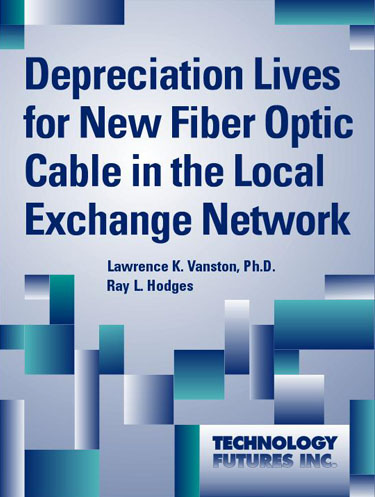
Depreciation Lives for New Fiber Optic Cable in the Local Exchange Network
Lawrence K. Vanston, Ph.D. and Ray L. Hodges
[ordering online? -- please see our return/refund policy]
 |
Depreciation Lives for New Fiber Optic Cable in the Local Exchange Network |
This report documents the changes in TFI's recommended depreciation life for newly-installed fiber optic cable in the local exchange network. TFI's prior recommendation was 15 to 20 years, which reflected the combined impacts of physical mortality, technological substitution, and access line losses due to competition. TFI's new recommendation is 20 to 25 years. This applies to the fiber cable that is going into the massive network upgrades such as AT&T's Project Lightspeed and Verizon's FiOS.
The new recommendation recognizes that the ILECs are making these investments with full knowledge that the market is competitive. Also, there is no obvious technological replacement for the full-spectrum fiber the ILECs are now placing. The report also addresses other factors that might impact economic depreciation lives. One example is obsolescence from new network architectures and topologies. Another is the impact of new competitors such as broadband powerline and wireless broadband.
The analysis concludes that, for general purposes, the 20 to 25 year recommended life is sufficient to account for these factors, at least for the time being. The new recommendations apply only to local exchange fiber and only to networks being upgraded to very high speed broadband such as Project Lightspeed and FiOS. The TFI depreciation life recommendations have long been used for valuation, regulatory, planning, and financial reporting. The TFI depreciation studies are sponsored by the Telecommunications Technology Forecasting Group, comprised of AT&T, Bell Canada, Qwest, and Verizon.
Table of Contents [back to top]
- Introduction and Summary
- Physical Mortality
- Fiber Technology
- Architectural or Topological Obsolescence
- Competition
- Summary of Factors Impacting Existing and New Fiber
1
Age-Survivor Curve for Fiber Optic Cable 2 Broadband Households by Nominal Data Rate 3a Illustrative Example of the Impact of a Technology Shift Coincident with 100 Mb/s Subscriber Forecast with 20% of the Fiber Replaced or Stranded 3b Illustrative Example of the Impact of a Technology Shift Coincident with 100 Mb/s Subscriber Forecast with 50% of the Fiber Replaced or Stranded 4 Illustrative Example of Potential Market Share Loss after Entry by New VHS Broadband Providers (Competitive Scenario 1) 5 Wireless Subscribers by Technology Generation 6 Illustrative Example of Possible Replacement by Future Wireless Services (Competitive Scenario 2) 7a Illustrative Example of the Impact of New VHS Broadband Providers (Competitive Scenario 1) 7b Illustrative Example of the Impact of Possible Replacement by Future Wireless Services (Competitive Scenario 2)
Pricing/Ordering Information [back to top]
January 2008, 15 pages
Sponsored by the TTFG